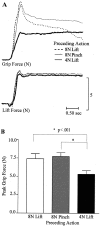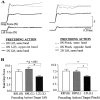Sensorimotor memory for fingertip forces: evidence for a task-independent motor memory
- PMID: 12629204
- PMCID: PMC6741962
- DOI: 10.1523/JNEUROSCI.23-05-01981.2003
Sensorimotor memory for fingertip forces: evidence for a task-independent motor memory
Abstract
When repetitively lifting an object with randomly varying mechanical properties, the fingertip forces reflect the previous lift. We examined the specificity of this "sensorimotor memory" by observing the effects of an isolated pinch on the subsequent lift of a known object. In this case, the pinch force was unrelated to the fingertip forces necessary to grip the object efficiently. The peak grip force used to lift the test object (4 N weight) depended on the preceding task. Compared with repetitively lifting the 4 N test object, the peak grip force was 2 N greater when a lift of the same object was preceded by a lift in which a hidden mass was attached to the object to increase the weight to 8 N. This 2 N increase in grip force also occurred when subjects lifted the 4 N test object after pinching a force transducer with a force of 8 N. Thus, similar grip forces were stored in sensorimotor memory for both tasks, and reflected subjects' use of 7.9 +/- 1.1 N to lift the 8 N object. Similar effects occurred when the preceding pinch or lift was performed with the opposite hand. The peak lift force was unaffected by the isolated pinch, suggesting that a generalized increase in fingertip and limb forces did not occur. We conclude that the sensorimotor memory is not specific for lifting an object. It is doubtful that this particular memory stores the physical properties of objects or reflects a forward internal model for predictively controlling fingertip forces.
Figures





Similar articles
-
Failure to disrupt the 'sensorimotor' memory for lifting objects with a precision grip.Exp Brain Res. 2008 Jan;184(2):157-63. doi: 10.1007/s00221-007-1088-8. Epub 2007 Aug 24. Exp Brain Res. 2008. PMID: 17717654
-
Sensorimotor memory for fingertip forces during object lifting: the role of the primary motor cortex.Neuropsychologia. 2007 Apr 9;45(8):1931-8. doi: 10.1016/j.neuropsychologia.2006.11.011. Epub 2007 Jan 19. Neuropsychologia. 2007. PMID: 17239907
-
Memory for fingertip forces: passive hand muscle vibration interferes with predictive grip force scaling.Exp Brain Res. 2004 Jun;156(4):444-50. doi: 10.1007/s00221-003-1801-1. Epub 2004 Jan 13. Exp Brain Res. 2004. PMID: 14722702
-
Force control in object manipulation--a model for the study of sensorimotor control strategies.Neurosci Biobehav Rev. 2013 Sep;37(8):1578-86. doi: 10.1016/j.neubiorev.2013.06.003. Epub 2013 Jun 17. Neurosci Biobehav Rev. 2013. PMID: 23791788 Review.
-
Sensory input and control of grip.Novartis Found Symp. 1998;218:45-59; discussion 59-63. doi: 10.1002/9780470515563.ch4. Novartis Found Symp. 1998. PMID: 9949815 Review.
Cited by
-
Internal models underlying grasp can be additively combined.Exp Brain Res. 2004 Apr;155(3):334-40. doi: 10.1007/s00221-003-1730-z. Epub 2004 Jan 9. Exp Brain Res. 2004. PMID: 14714157
-
Failure to disrupt the 'sensorimotor' memory for lifting objects with a precision grip.Exp Brain Res. 2008 Jan;184(2):157-63. doi: 10.1007/s00221-007-1088-8. Epub 2007 Aug 24. Exp Brain Res. 2008. PMID: 17717654
-
Credit assignment between body and object probed by an object transportation task.Sci Rep. 2017 Oct 17;7(1):13415. doi: 10.1038/s41598-017-13889-w. Sci Rep. 2017. PMID: 29042671 Free PMC article.
-
The effect of externally generated loading on predictive grip force modulation.Neurosci Lett. 2007 Feb 27;414(1):10-5. doi: 10.1016/j.neulet.2006.10.026. Epub 2007 Feb 6. Neurosci Lett. 2007. PMID: 17289265 Free PMC article.
-
Flexible Control of Safety Margins for Action Based on Environmental Variability.J Neurosci. 2015 Jun 17;35(24):9106-21. doi: 10.1523/JNEUROSCI.1883-14.2015. J Neurosci. 2015. PMID: 26085634 Free PMC article. Clinical Trial.
References
-
- Burstedt MKO, Edin BB, Johansson RS. Coordination of fingertip forces during human manipulation can emerge from independent neural networks controlling each engaged digit. Exp Brain Res. 1997;117:67–79. - PubMed
-
- Classen J, Liepert J, Wise S, Hallett M, Cohen L. Rapid plasticity of human cortical movement representation induced by practice. J Neurophysiol. 1998;79:1117–1123. - PubMed
-
- Cole K, Rotella D. Old age impairs the use of arbitrary visual cues for predictive control of fingertip forces during grasp. Exp Brain Res. 2002;143:35–41. - PubMed
-
- Dubrowski A, Proteau L, Carnahan H. Practice influences the coordination of visual and haptic inputs during grasping. Soc Neurosci Abstr. 1999;25:1913.
Publication types
MeSH terms
Grants and funding
LinkOut - more resources
Full Text Sources
Medical
